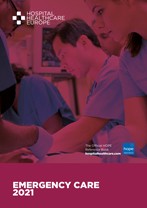Three key clinical findings have been found to be independently associated with an MRI-confirmed diagnosis of cauda equine compression.
Atraumatic back pain (i.e., with minimal tissue damage) is a common problem at emergency departments (ED), with a 2017 systematic review finding that it accounts for between 0.9% and 17.1% of all attendances.1 Cauda equine syndrome (CES) is a rare condition in which the lumbosacral nerve roots are compressed (hence the term cauda equine compression) that is commonly due to a central disc prolapse at the L4/5 or L5/SI level.2 There is some uncertainty over the incidence of the condition but a 2020 systematic review found a combined estimate of 0.27% from four studies of those with low-back pain presenting to secondary care.3 Untreated or missed as a diagnosis, CES can lead to permanent neurological dysfunction and which includes loss of bladder control, sexual function and a sensory/motor deficit. Although the diagnosis can be confirmed by MRI, access to this imaging modality is limited in ED hence clinicians need to identify those patients who require urgent imaging.
Which, if any, clinical symptoms obtained during a routine examination have predictive accuracy for the diagnosis of CES, was the subject of a study by a team from the Department of Spinal Surgery, Salford Royal NHS Foundation Trust, Salford, UK.4 The team undertook a retrospective case review over a 4-year period of all ED atraumatic pain at a single site major trauma spinal referral centre. They included patients 18 years and older who had undergone a reference standard imaging (MR spine) due to a clinical suspicion of CES. The team undertook a univariate logistic regression analysis to identify those subjective and objective risk factors associated with a diagnosis of CES and included only those that were deemed statistically significant (p < 0.05) in a multivariate analysis.
Findings
During the 4-year study period, 2036 patients presented at the ED with back pain of which 996 were referred to exclude CES. These patients had a median age of 46 years and radiological compression of the cauda equine was reported in 11.1% (111/996) of them, of whom 109 went on to have urgent surgical decompression. Looking at the clinical symptoms, both bilateral leg pain (with or without back pain) was significantly more frequent in those with CES (p < 0.001) as was the perception of bilateral weakness (p = 0.002).
In multivariate analysis, there were three significant and independent predictors of CES. Bilateral leg pain, with or without back pain (odds ratio, OR = 1.90, 95% CI 1.2–3.0, p = 0.006), objective sensory loss in a dermatomal distribution (OR = 1.70, 95% CI 1.1–2.7, p = 0.01) and finally, the loss of bilateral ankle and/or knee jerk reflexes (OR = 3.4, 95% CI 1.8–6.6, p < 0.0001). The team found limited diagnostic utility for a digital rectal examination.
The authors concluded that further prospective work was needed to validate their findings and to develop risk prediction tools to guide emergency imaging decisions.
References
- Edwards J et al. Prevalence of low back pain in emergency settings: a systematic review and meta-analysis. BMC Musculoskelet Disord 2017;18(1):143
- Barraclough K. Cauda equine syndrome. BMJ 2021;372: n32
- Hoeritzauer I et al. What is the incidence of cauda equina syndrome? A systematic review. J Neurosurg Spine 2020 doi: 10.3171/2019.12.SPINE19839.
- Angus M et al. Determination of potential risk characteristics for cauda equina compression in emergency department patients presenting with atraumatic back pain: a 4-year retrospective cohort analysis within a tertiary referral neurosciences centre. Emer Med J 2021 doi:10.1136/ emermed-2020-210540





